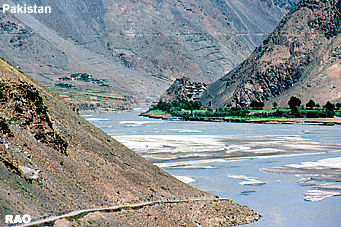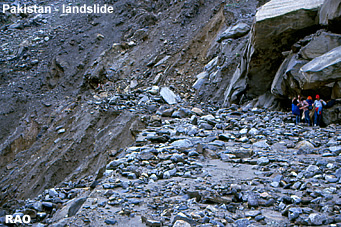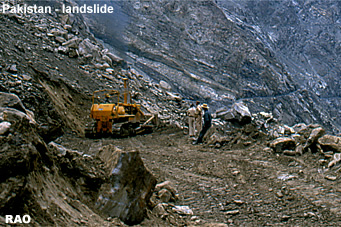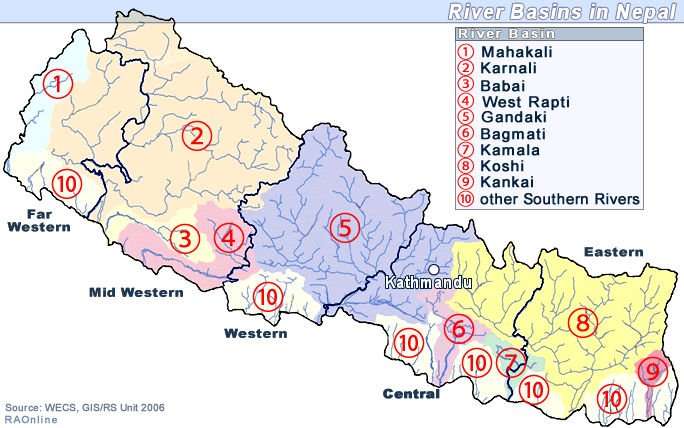 |
Nepal Himalayas Glaciers |
 |
Nepal Information |
|
|
 |
|
Too much or too little water in the Himalayas
|

|
Hundreds of millions of people in the Hindu Kush-Himalayan region and in the river basins downstream are being forced to adapt to a new reality: climate change.
Climate change is increasing uncertainty and the risk for extreme droughts interspersed with extreme floods that are challenging food security, housing, infrastructure, business and even survival.
Even hardy mountain populations, adapted for centuries to survival in extreme environments, are undergoing events so unprecedented that their traditional coping strategies are being overwhelmed by the events unfolding.
These are some of the main findings of a new study released today at the UN climate convention meeting in Copenhagen by the International Centre for Integrated Mountain Development (ICIMOD), United Nations Environment Programme (UNEP), and the Center for International Climate and Environmental Research (CICERO).
The findings are based on five field teams in China, India, Pakistan and Nepal who took part in this unique collaborative pilot study to look at the realities facing mountain populations and hundreds of millions people downstream.
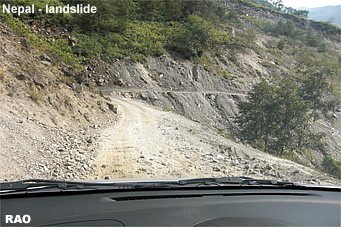 |
|
The acute experiences of people in this region are living proof of the pressures some societies are already enduring as a result of the onset of climate change - adaptation here is not just a necessity but a question of local communities' very survival," said Achim Steiner, UN Under-Secretary General and UNEP Executive Director. |
|
In Nepal, a country normally known as a country of water abundance, extreme droughts in some cases lasting years have impacted large parts of the country.
People who can afford machinery respond by digging trenches in the dry river beds.
Now the trenches and tube wells have to be guarded to protect them against those who cannot afford to get water this way, leading to increased inequality and conflicts in the society.
In Assam and Bihar in India, embankments built to contain the Koshi River have led to waterlogging, and even worse, cause catastrophic floods when they suddenly burst as a result of improper construction and inadequate maintenance. People who have settled closest to the embankments are the most vulnerable and take the heaviest toll.
"Policies that determine people's access to resources when facing water stress and floods are currently weak throughout the region, thus people rely on their own innovations," said Andreas Schild, Director General of ICIMOD. "Governments have to find ways to support improved livelihood strategies, and increase people's influence in the governance of infrastructure, such as embankments," he added.
For the impoverished, everyday activities are focused on immediate survival, thus rendering the hope of developing long-term resilience and economic development even more remote, says the report.
In some places, necessity has forced local farmers to sell off livestock and land during droughts to pay short-term debts, to cope with elevated food prices, or to rebuild destroyed housing - resulting among others from extreme climate events and inadequate policies elsewhere in the world.
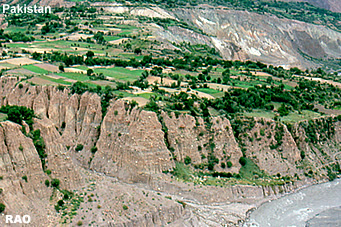 |
|
Traditional institutions, like the Gram in Chitral, Pakistan, help people to manage scarce water resources in an equitable way. In Pakistan, a near doubling of the population in just 40 years will also challenge the food production, which is mainly based on irrigation from rivers fed by meltwater from snow and glaciers in the mountains.
|
|
Social networks and cultures are an asset in dealing with the extremes, such as the designation of women as water guards in Yunnan province in China, to manage water conflicts.
Networks can also ensure that migrants find help, as in Chitral, Pakistan, where kinship and traditional hospitality help fellow villagers re-settle after catastrophes. But in some cases traditions can also challenge the need for new ways to adapt.
In Assam, India, non-Mishing people are unwilling to use the flood-tolerant housing techniques developed by the Mishing because they do not wish to be associated with another caste.
Traditionally, many of the government policies in the countries of the region have been sectoral in nature, such as the investments in irrigation infrastructure in Yunnan. These investments, focused on increasing cash crop production at the national level, have largely improved and strengthened lowland communities' coping capacity and productivity - but they have not helped the up-land communities in dealing with water stress, as this was not their focus.
Similarly, road development in Nepal has increased market access and thereby supported new livelihoods, but has destroyed many traditional streams and wells, reducing local ability to cope with drought. Restoration programmes following droughts have frequently simply reconstructed buildings in high-risk flood zones, even new schools have been constructed in high-risk flash-flood locations.
A chief finding of the report is the need for governments to prioritise the development and improvement of national and regional policies to provide better support for local adaptation against a more extreme climate, helping to shift planning from acute survival towards long-term resilience. Many of the countries in the region, such as India, have assigned special institutions nationally to address disaster management.
"The report is ground-breaking in that it brings together best-practices aimed at increasing adaptation and resilience from across borders in Pakistan, India, Nepal and China," Mr. Steiner said. "If the world is to deal decisively with climate change, we must also address the need for programmes targeted towards adaptation strategies to build long-term resilience. Local people already have to make choices daily, and governments with adequate international assistance must step up their efforts to support them in coping," he added.
The report comes as the result of a two-year pilot assessment in the region, coordinated by ICIMOD, with partners from a range of institutions in China, India, Pakistan and Nepal, supported by expertise from UNEP's polar and cryosphere centre in Norway, GRID-Arendal, and the Norwegian Center for International Climate and Environmental Research (CICERO).
The study was performed through field teams who successfully conducted field investigations under challenging conditions in Chitral, Northern Pakistan, the hills of Koshi Basin, Nepal, Koshi Basin flood plains in Bihar, India, Brahmaputra flood plains in Assam, India, and in hill areas in Mekong and Salween river basins in Yunnan, China. The study was financed by the Norwegian and Swedish Governments.
Key Findings from the Report and Statistics on the Hindu-Kush Himalayan region:
 Extreme climate events are destroying crops, depleting water resources, causing losses in livestock, cropland, and agricultural productivity, and destroying the meagre infrastructure present, thus reducing market access and access to public services. Extreme climate events are destroying crops, depleting water resources, causing losses in livestock, cropland, and agricultural productivity, and destroying the meagre infrastructure present, thus reducing market access and access to public services.
 Rainwater harvesting and revival of traditional and new water storage systems are crucial for water storage but must be adapted to the more extreme water events. Rainwater harvesting and revival of traditional and new water storage systems are crucial for water storage but must be adapted to the more extreme water events.
 Improved government policies must be developed to support and facilitate local adaptation strategies and to increase long-term resilience, not just disaster management. Improved government policies must be developed to support and facilitate local adaptation strategies and to increase long-term resilience, not just disaster management.
 Increased efficiency of irrigation and water use is urgently needed - a new Blue Revolution in Asia could increase water availability for crop production. Increased efficiency of irrigation and water use is urgently needed - a new Blue Revolution in Asia could increase water availability for crop production.
 Livelihood diversification increases resilience to extreme events as much as income level and should be supported through investments. Livelihood diversification increases resilience to extreme events as much as income level and should be supported through investments.
 Government policies must support and strengthen social capital and networks. Government policies must support and strengthen social capital and networks.
|
Some regional statistics:
 The warming in the Himalayas appears to be much faster than the global average, for example, 0.6 degrees Centigrade per decade in Nepal compared with the global average of 0.74 degrees Centigrade over the last 100 years. The rate of change is higher at higher altitudes. The warming in the Himalayas appears to be much faster than the global average, for example, 0.6 degrees Centigrade per decade in Nepal compared with the global average of 0.74 degrees Centigrade over the last 100 years. The rate of change is higher at higher altitudes.
 Glaciers are generally receding in the Hindu-Kush Himalayas, some 40-80% have been projected to be lost by the end of the century, with the exception of the Karakoram, where the glaciers have been more stable. Glaciers are generally receding in the Hindu-Kush Himalayas, some 40-80% have been projected to be lost by the end of the century, with the exception of the Karakoram, where the glaciers have been more stable.
 The proportion of glacial melt in rivers varies from 2-50%, with mountain snow and ice being critical for much larger shares of the flow in some rivers. The proportion of glacial melt in rivers varies from 2-50%, with mountain snow and ice being critical for much larger shares of the flow in some rivers.
 Irrigation water from rivers sustains nearly 55% of Asia's cereal production and around 25% of the world cereal production, feeding over 2.5 billion people in Asia. Another UN report, "The Environmental Food Crisis", warned that the melting glaciers and snow could jeopardize world food security and drive prices to unprecedented levels. Irrigation water from rivers sustains nearly 55% of Asia's cereal production and around 25% of the world cereal production, feeding over 2.5 billion people in Asia. Another UN report, "The Environmental Food Crisis", warned that the melting glaciers and snow could jeopardize world food security and drive prices to unprecedented levels.
 The most serious short-term changes are probably related to the frequency and magnitude of extreme weather events, such as high intense rainfall leading to flash floods, landslides, and debris flows, as well as extreme drought. The most serious short-term changes are probably related to the frequency and magnitude of extreme weather events, such as high intense rainfall leading to flash floods, landslides, and debris flows, as well as extreme drought.
 The hydrological role of snow and ice from the mountains is particularly high for the Tarim, Syr Darya, Amu Darya, Indus, Ganges, Brahmaputra, YanGIZe and Huang He (Yellow) rivers. The hydrological role of snow and ice from the mountains is particularly high for the Tarim, Syr Darya, Amu Darya, Indus, Ganges, Brahmaputra, YanGIZe and Huang He (Yellow) rivers.
 Over 1.3 billion people live directly in watersheds critically dependent upon glacier melt, snowmelt and water from the Hindu Kush-Himalayas. Over 1.3 billion people live directly in watersheds critically dependent upon glacier melt, snowmelt and water from the Hindu Kush-Himalayas.
 An estimated 516 million people in China, 526 million people in India and Bangladesh, 178 million people in Pakistan and northern India, and 49 million people in Central Asia, including Xinjiang in China, are thought to be at risk from water shortages. An estimated 516 million people in China, 526 million people in India and Bangladesh, 178 million people in Pakistan and northern India, and 49 million people in Central Asia, including Xinjiang in China, are thought to be at risk from water shortages.
 Floods impact several million people every year in the region, and lead to thousands of casualties. Floods impact several million people every year in the region, and lead to thousands of casualties.
 The risk of glacial lake outburst floods ('GLOFS'), the sudden bursting of natural dammed melt lakes at the mouth of glaciers, is increasing as glaciers continue to retreat; with a potential to destroy lives, livelihoods, and infrastructure up to 100 kilometers downstream. The risk of glacial lake outburst floods ('GLOFS'), the sudden bursting of natural dammed melt lakes at the mouth of glaciers, is increasing as glaciers continue to retreat; with a potential to destroy lives, livelihoods, and infrastructure up to 100 kilometers downstream.
|
 |

|
| Source:
ICIMOD, International Centre for Integrated Mountain Development , December 2009 |
ICIMOD
The
International Centre for Integrated Mountain Development (ICIMOD) is an
independent 'Mountain Learning and Knowledge Centre' serving the eight
member countries of the Hindu-Kush-Himalayas - Afghanistan, Bangladesh,
Bhutan, China, India, Myanmar, Nepal and Pakistan - and the global mountain
community. ICIMOD is a non-political intergovernmental organisation which,
since 1983, has encouraged technical cooperation between governments in
the region and whose primary objective is to help promote the development
of environmentally sound mountain ecosystems and improve the living standards
of the mountain population. www.icimod.org

|
|
Glaciers
flowing down from Annapurna I |
top
|
more information
|

|
| Himalayas |
|
 |
| Reports |
 |
| Himalayas |
Snow, Ice, Glacier, Glacial Lakes and Floods Reports |
 |
|
Links |

|
 |
 |
External
link |
 |
International
Centre for Integrated Mountain Development
ICIMOD |
|
 |
|






